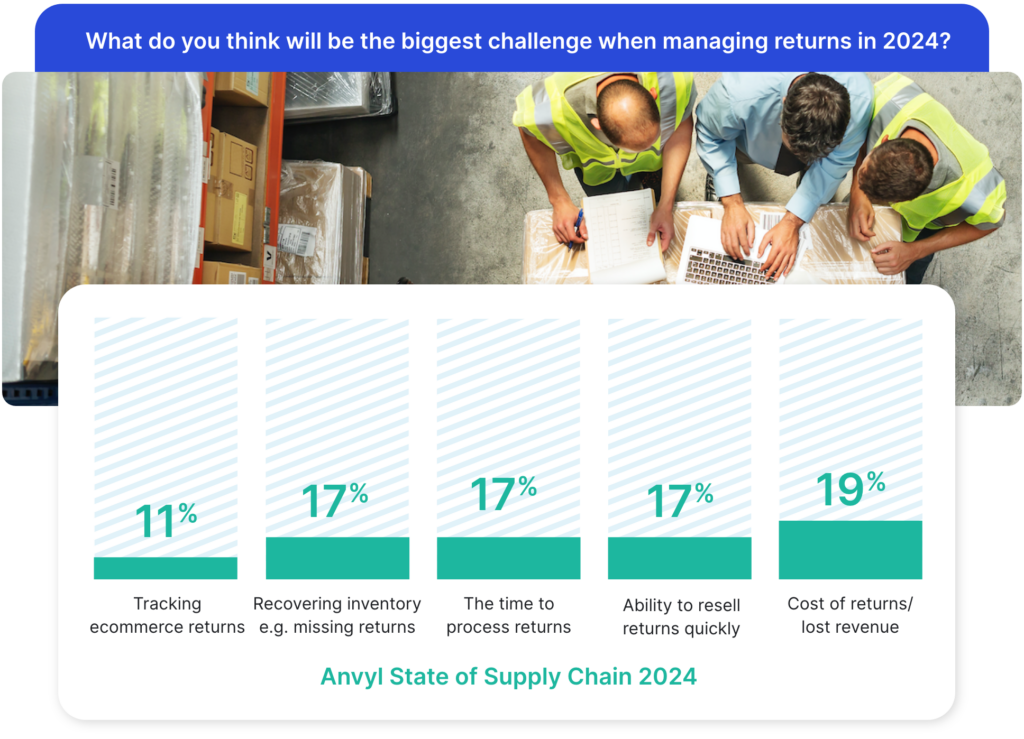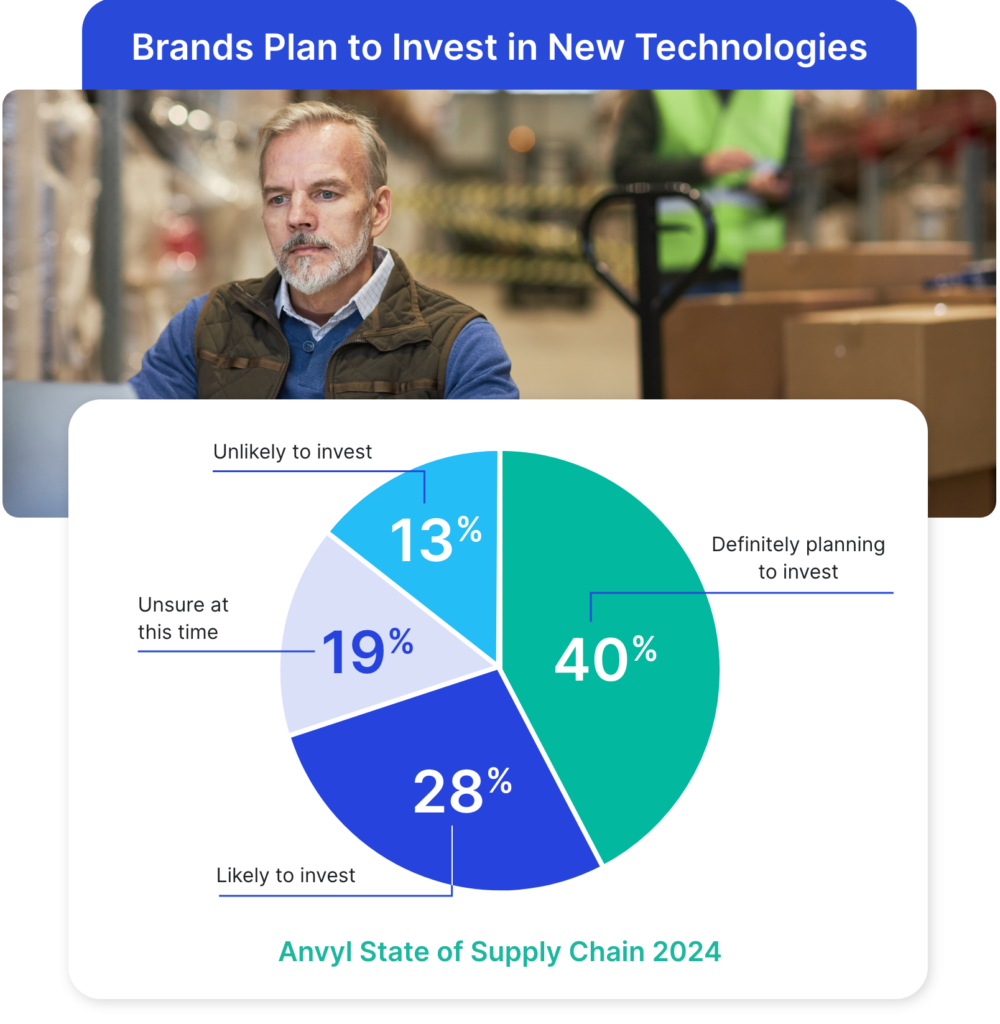The Current State of Supply Chain 2024Key trends and strategies to optimize your supply chain
The past year presented a multitude of challenges for consumer goods brands. Supply shortages, transportation delays, labor disputes, and political and regulatory shifts were some of the top challenges. Many of these will continue to impact the current state of the supply chain in 2024.
To uncover how brands will confront these hurdles and gauge which technology trends will help overcome them, we surveyed consumer brands with annual revenues between $15 million and $750 million about how they plan to manage their supply chain this year and beyond.
We also invited input on current trends in supply chain management from other leaders in the industry, including our partners at ShipBob, ReturnBear, and Vertice.
Ready to dive in? Let’s start with the top supply chain risks and disruptions brands will face in the supply chain this year.
Top Supply Chain Risks and Disruptions
Disruptions from years past will continue to strain the supply chain and challenge consumer brands to continually adapt their procurement strategy.
The top challenges brands plan to encounter again this year include supply shortages and transportation delays, among others.
The top disruption predicted for 2024? 43% of survey respondents agree that supply shortages will cause the most disruptions and challenges in supply chain this year.
The Current State of Supply Chain 2024

So how should brands navigate these challenges? Gain more visibility into the factors they can control within their supply chain to navigate factors they can’t control.
In fact, half of brands surveyed identified visibility as a top priority for them in 2024.
So how can they increase visibility? There are three key points to consider:
- Brands need advanced tracking, real-time data, and flexible, collaborative tools to suit their unique workflows when moving consumer goods through their supply chain.
- Technology, like supply chain management software, is a crucial tool that empowers organizations to proactively identify and mitigate potential disruptions.
- Supply chain management software can significantly improve inventory visibility and streamline fulfillment operations so that the right products reach the right consumers at the right time.
Better supply chain visibility means less empty shelves, and happier customers with products in hand.
Brands also plan to experiment with new fulfillment tactics to mitigate risks, like supply shortages, in 2024.
Our partners at ShipBop have a few tips for brands who want to mitigate risk when it comes to fulfillment in their supply chain:
As the global supply chain continues to evolve, the ability to anticipate and respond to changes while moving consumer goods, especially in the first mile, will define brand success in 2024.
Current trends in supply chain management show that inventory and fulfillment aren’t the only areas of supply chain operations facing enduring challenges this year.

Top Operational Supply Chain Challenges
Brands face additional challenges across their supply chain operations, specifically regarding distribution operations, data and reporting, and the increasingly important role sustainability plays in consumer purchasing decisions.
Distribution Challenges
- Economic challenges, global conflicts, and other disruptions will challenge brands’ distribution networks.
- For brands focused on driving omnichannel sales, one aspect of distribution operations that poses the most significant challenge? Managing returns.
- Respondents specifically highlighted the three areas they’re most concerned about: the cost of returns/lost revenue, the time it takes to process returns, and an inability to resell returns quickly.
The Current State of Supply Chain 2024

What is the best way to address these challenges? Automate key returns processes with the help of tools like returns management software.
Data Analytics and Reporting Challenges
To run more efficient distribution operations and plan for potential disruptions, brands must make data-driven decisions about which products they send to which distributors, how much they send, and how they should price them.
The challenge? Many consumer brands have disparate data scattered across multiple platforms (or worse, spreadsheets) that’s also inaccurate, especially if supply chain teams manually input this data:
- Consumer brands cite poor data quality (35%), data inaccuracy and inconsistencies (34%), and delays in data processing and analysis (30%) as the most common data problems within their supply chain.
- Addressing these common data problems is pivotal for organizations to harness the full potential of supply chain data analytics and reporting in optimizing their supply chain operations.
Sustainability Challenges
Brands plan to focus more on supply chain sustainability this year, marked by a significant shift towards environmentally responsible practices in response to consumers’ desire to do business with companies prioritizing ethical and eco-friendly initiatives.
Brands can make significant strides towards running more sustainable supply chains by evaluating new and existing providers, including looking at third-party logistic partners, sustainable suppliers, and tools that specialize in visibility.
ShipBob’s 2024 State of Fulfillment Report found that 35% of brands plan to either ship to or fulfill orders in new countries, 21% of which will physically fulfill orders in new countries.
Localizing your fulfillment strategy to ship orders domestically from multiple countries can reduce emissions.”
Brands can also lower their environmental footprint by better managing returns with new innovations.
We’ll see fully processed returns turning into forward supply for the next customer instead of making carbon-heavy journeys back to central fulfillment locations.”
Top Trends in Supply Chain Budgets and Pricing
Consumer brands are carefully considering pricing, budgeting, and other ways to cut costs or optimize supply chain management in 2024.
Consumer brands will prioritize directing investments to these five critical areas:
Procurement Efficiency:
Technology:
Inventory Management:
Logistics and Transportation:
Production and Manufacturing:
While a significant 62% of surveyed respondents indicated an upswing in their supply chain technology budget for the year, brands should also evaluate their existing tech stack when evaluating budgets and areas to increase or decrease investment within their supply chain.
Strategic financial allocations like this are pivotal in streamlining supply chain processes, improving customer satisfaction, and increasing operational efficiency.
Top Trends in Procurement and Supplier Management
In an increasingly competitive market, consumer brands must keep up with the demand for existing products while also creating new products that capture consumers’ attention and drive more sales.
The key to both? Strong relationships with suppliers:
- 44% of businesses will focus on reducing procurement costs through streamlined supplier selection and negotiation processes.
- More than a third of organizations (36%) say they are increasing investment towards enhancing supplier relationship management to negotiate better terms and reduce supply costs.
- More than half (51%) of businesses plan to collaborate more closely with suppliers to forecast demand accurately to mitigate supply uncertainty.
While strong supplier relationships help brands navigate and react faster to unexpected delays, they can’t build strong relationships without full visibility into their supply chain.
Top Supply Chain Visibility Trends
As the quest to move consumer goods faster reaches a pivotal point in 2024, supply chain visibility is more critical than ever.
The ability to gain real-time insights into the first mile of the supply chain is a top priority for businesses that want to respond to market dynamics and stay competitive.
Our survey shows that brands see inventory management, purchase order management, and supplier communication as the most significant areas of opportunity for more visibility in their supply chain.
The Current State of Supply Chain 2024

Increased visibility into inventory makes it easier to closely monitor stock levels, minimizes overstock or shortages, and optimizes warehousing space.
Better visibility into purchase orders leads to smoother procurement and fulfillment, and more transparent communication with suppliers makes moving consumer goods throughout the supply chain more efficient.

Top Supply Chain Technology Trends
With supply chain visibility a central theme for 2024, consumer brands plan to turn to new technology, like supply chain management software, to streamline their first mile and better manage purchase orders.
The Current State of Supply Chain 2024

And as brands consider investing in new technologies, it’s vital that they choose customizable and flexible solutions that will support them as they grow.
Brands that do this, have the bandwidth to focus on more strategic initiatives and quickly gain an edge over the competition.”
Conclusion
While disruptions continue to challenge how brands manage their supply chain, it’s also clear that these challenges are catalysts for many positive changes.
These challenges and trends in supply change management prompt brands to reassess and fortify their supply chain strategies by prioritizing supply chain visibility in 2024 and increasing their investments in customizable technology.
What’s the key to success beyond 2024?
For the answer, we’ll meet you back here for next year’s State of Supply Chain Survey.
About the Survey:
Conducted in January 2024, our survey encompassed a diverse range of more than 500 consumer brands in the apparel, retail, and wholesale space, with annual revenues ranging from $15 million to $750 million.
Respondents include CEOs/Owners, C-Level Executives, Senior Management, and Supply Managers.
Ready to learn more about how to increase visibility into your supply chain?
Get a demo today.